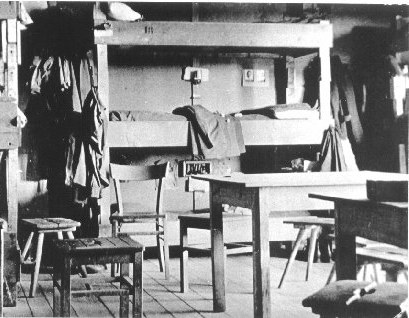| DATE |
ACTION |
| April 1944 |
Fifty POWs were executed after escaping from Stalag Luft III at Sagan. |
| 13 July 1944 |
Evacuation of Stalag Luft VI at Heydekrug in Lithuania begins, to Stalag Luft IV at Gross Tychow involving a force march and 60hr journey by ship to Swinemunde, or by force march and cattle train to Stalag XX-A at Thorn in Poland. |
| 17 December 1944 |
The SS shot seventy-one captured American POWs in the Malmedy massacre. |
| 24 December 1944 |
POW work camps near Konigsberg (now Kaliningrad) are evacuated. |
| 27 December 1944 to April 1945 |
POWs at Stalag VIII-B (formerly Stalag VIII-D) at Teschen began their forced march through Czechoslovakia, towards Dresden, then towards Stalag XIII-D at Nuremberg and finally on to Stalag VII-A at Moosburg in Bavaria. |
| 12 January 1945 |
Red Army launched offensive in Poland and East Prussia. |
| 19 January 1945 |
Evacuation from Stalag Luft 7 at Bankau, near Kreuzberg, Poland, begins in blizzard conditions - 1,500 prisoners were force marched then loaded onto cattle trucks and taken to Stalag III-A at Luckenwalde, south of Berlin. |
| 22 January 1945 |
Stalag 344 at Lamsdorf, Silesia was evacuated. |
| 23 January 1945 |
Evacuation began at Stalag XX-B at Marienburg, Danzig. |
| 27 January 1945 |
Red Army liberates Auschwitz. |
| 27 January 1945 to February 1945 |
Evacuation began at Stalag Luft III, Sagan, to either Stalag III-A at Luckenwalde, 30 km south of Berlin, or to Marlag und Milag Nord, near Bremen, or to Stalag XIII-D, near Nuremberg, then onto Stalag VII-A near Moosburg, Bavaria. |
| 6 February 1945 to March 1945 |
Evacuation from Stalag Luft IV at Gross Tychow, Pomerania began an eighty-six day forced march to Stalag XI-B and Stalag 357 at Fallingbostel. Many prisoners were then marched from here at the end of the war towards Lubeck. |
| 10 February 1945 |
Stalag VIII-A at Gorlitz was evacuated. |
| 14 February 1945 |
British and American bombers attacked Dresden. |
| 19 March 1945 |
Hitler issued the Nero Decree. |
| 3 April 1945 |
Stalag XIII-D at Nuremberg was evacuated. |
| 6 April 1945 |
Stalag XI-B and Stalag 357 at Fallingbostel were evacuated. |
| 16 April 1945 |
POWs left behind at Fallingbostel were liberated by the British Second Army. |
| 16 April 1945 |
Oflag IV-C, (Colditz Castle), was liberated. |
| 17 April 1945 |
Bergen-Belsen concentration camp was liberated. |
| 19 April 1945 |
POW column was attacked by allied aircraft at Gresse resulting in 60 fatalities. |
| 22 April 1945 |
Stalag III-A at Luckenwalde was liberated by Soviet forces. |
| 27 April 1945 |
US and Soviet forces linked up at the River Elbe. |
| 29 April 1945 |
Stalag VII-A at Moosburg was liberated by Patton's Third United States Army. |
| 30 April 1945 |
Berlin falls to the Red Army and Hitler commits suicide. |
| 4 May 1945 |
German forces surrendered on Luneburg Heath. |
| 8 May 1945 |
The last POWs evacuated from Stalag XI-B at Fallingbostel are liberated on VE day. |
| 12 May 1945 |
The Red Army releases British and American POWs at Stalag III-A, Luckenwalde. |







